英语科技论文写作
- 格式:ppt
- 大小:121.00 KB
- 文档页数:55
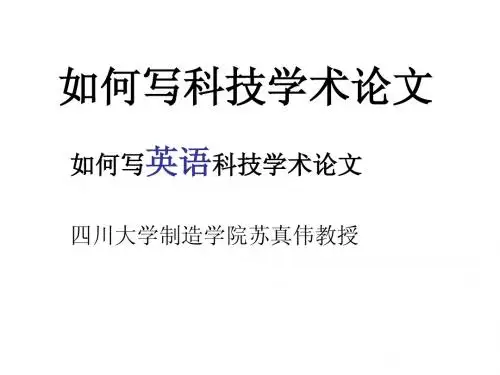
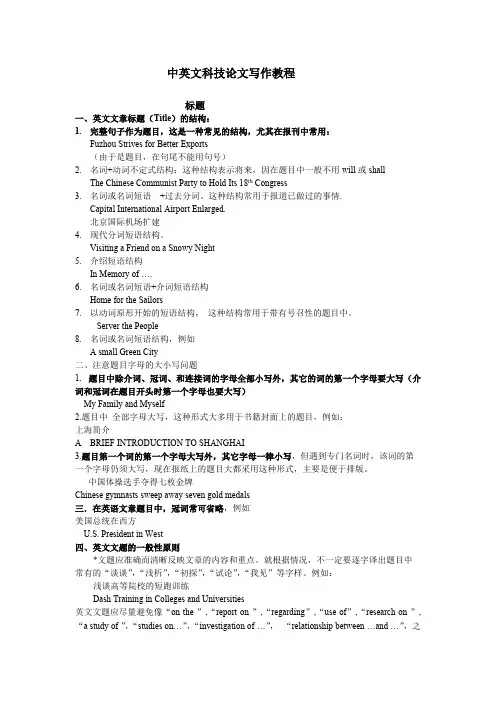
中英文科技论文写作教程标题一、英文文章标题(Title)的结构:1.完整句子作为题目,这是一种常见的结构,尤其在报刊中常用:Fuzhou Strives for Better Exports(由于是题目,在句尾不能用句号)2.名词+动词不定式结构:这种结构表示将来,因在题目中一般不用will或shallThe Chinese Communist Party to Hold Its 18th Congress3.名词或名词短语+过去分词。
这种结构常用于报道已做过的事情.Capital International Airport Enlarged.北京国际机场扩建4.现代分词短语结构。
Visiting a Friend on a Snowy Night5.介绍短语结构In Memory of ….6.名词或名词短语+介词短语结构Home for the Sailors7.以动词原形开始的短语结构,这种结构常用于带有号召性的题目中。
Server the People8.名词或名词短语结构,例如A small Green City二、注意题目字母的大小写问题1. 题目中除介词、冠词、和连接词的字母全部小写外,其它的词的第一个字母要大写(介词和冠词在题目开头时第一个字母也要大写)My Family and Myself2.题目中全部字母大写,这种形式大多用于书籍封面上的题目,例如:上海简介A BRIEF INTRODUCTION TO SHANGHAI3.题目第一个词的第一个字母大写外,其它字母一律小写,但遇到专门名词时,该词的第一个字母仍须大写,现在报纸上的题目大都采用这种形式,主要是便于排版。
中国体操选手夺得七枚金牌Chinese gymnasts sweep away seven gold medals三.在英语文章题目中,冠词常可省略,例如美国总统在西方U.S. President in West四、英文文题的一般性原则*文题应准确而清晰反映文章的内容和重点。
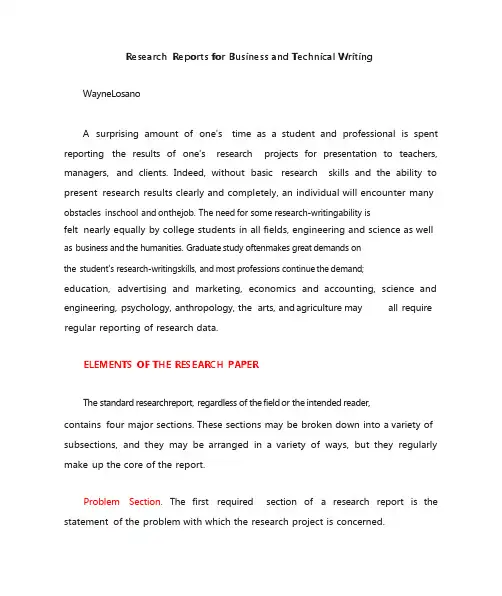
Research Reports for Business and Technical WritingWayneLosanoA surprising amount of one's time as a student and professional is spent reporting the results of one's research projects for presentation to teachers, managers, and clients. Indeed, without basic research skills and the ability to present research results clearly and completely, an individual will encounter many obstacles inschool and onthejob.The need for some research-writingability isfelt nearly equally by college students in all fields, engineering and science as well as business and the humanities.Graduate study oftenmakes great demands onthe student's research-writingskills,and most professions continue the demand;education, advertising and marketing, economics and accounting, science and engineering, psychology, anthropology, the arts, and agriculture may all require regular reporting of research data.ELEMENTS OF THE RESEARCH PAPERThe standard researchreport,regardless of the field or the intended reader,contains four major sections. These sections may be broken down into a variety of subsections, and they may be arranged in a variety of ways, but they regularly make up the core of the report.Problem Section. The first required section of a research report is the statement of the problem with which the research project is concerned.This sectionrequires a precise statement of the underlyingquestionwhichtheresearcher has set out to answer. In this same section there should be anexplanation of the significance - social, economic, medical, psychological, educational,etc.-of the question;inother words,why the investigationwas worth conducting. Thus, if we set out, for example, to answer the question "What is the effect of regular consumption of fast foods on the health of the American teenager?" we must explain that the question is thought to have significant relevance tothe healthof this segment of the'populationandmight leadtosomesort of regulations on such foods.A frequent subsection of this problem section is a review of past research on the topic being investigated. This would consist of summaries of the contributions of previous researchers tothe questionunder considerationwithsome assessmentof the value of these contributions. This subsection has rhetorical usefulness inthat it enhances the credibility of the researcher by indicating that the data presented is based ona thoroughknowledge of what has beendone inthe fieldand, possibly, grows out of some investigative tradition.Procedures Section. The second major sectionof the researchreport details,with as much data as possible, exactly how the study was carried out. This section includes descriptionof any necessary equipment,how the subjects were selectedifsubjects were used, what statistical technique was used to evaluate the significance of the findings, how many observations were made and when, etc. An investigationof the relative effectiveness of various swim-strokes would have todetail the number of swimmers tested, the nature of the tests conducted, theexperience of the swimmers, the weather conditions at the time of the tests, andany other factors that contributed to the overall experiment. The goal of the procedures section is to allow the reader to duplicate the experiment if such were desired to confirm, or refute, your findings.Results Section. The third, and perhaps most important, section of the research report is the presentation of the results obtained from the investigation. The basic rule inthis sectionis to give all data relevant to the researchquestioninitially asked. Although, of course, one's natural tendency might be to suppressany findings which do not in some way support one's hypothesis, such dishonesty is antithetical to good research reporting in any field. If the experiments undertaken fail to prove anything, if the data was inadequate or contrary to expectations, the report should be honestly writtenand as complete as possible,just as it would be if the hypothesis were totally proven by the research.Discussion Section . The final required section of a research report is a discussion of the results obtained and a statement of any conclusions which may be drawnfromthose results. Of primary interestinbusiness andtechnical researchreports is the validity of the results as the bases for company decisions: Will ourplanned construction project meet federal environmental guidelines and beapproved for building? Will this new program attract skilled personnel to our werethey validly obtained, arethey completeor limited, arethey applicableover awiderangeof circumstances? Thediscussion section should also point out what discussion section of theresearch report must evaluatetheresearch results fully:Thus, the company? Will this new oil recovery technique be financially feasible?questions remain unansweredandperhaps suggest directions for further research.STYLE OF RESEARCH REPORTSResearch reports are considered formal professional communication. As such, thereis li t leemphasis ona lively style,although,of course,thereis noobjectiontowriting that is pleasing and interesting. The primary goals of professional communication are accuracy, clarity, and completeness. The rough draft of any researchreport shouldbe editedtoensure that all data is correctly presented,thatall equipmentis listed,thatall results areproperly detailed.As anaidtothereader,headings indicating at least the major sections of the report should be used, and all data should be presented under the proper headings. In addition to their function of suggesting to the reader the contents of each section, headings enhance the formal appearance and professional quality of the report, increase to some degree the writer's credibility by reflecting a logical and methodical approach to the reporting process, and eliminate the need for wordy transitional devices between sections.Researchdata should be presented ina way that places proper emphasis onmajor aspects of the project.For different readers different aspects will take on different degrees of importance, and some consideration should be given to structuringresearchreports differently for different audiences.Management,forexample,will be most concerned withthe results of a researchproject,and thusthe results section should be emphasized, probably by presenting it immediately after the problemsection and before the procedures section.Other researcherswould be most interested in the procedures section, and this should be highlighted in writing up research projects for publication in professional journals or for presentation at professional conferences. For non-technical readers and federal agencies, the implications of the results might be the most important consideration, and emphasis should be placed on the discussion of the report for this readership.For additional clarity and emphasis, major results should be presented in a visual format - tables, charts, graphs, diagrams - as well as in a verbal one.Beyond checking the report for clarity and accuracy in the presentation of technical data,the author of a researchreport shouldreview for basic grammaticaland mechanical accuracy. Short sentences are preferable to long in the presentation of complex information. Listings should be used to break up long passages of prose and to emphasize information.The research writer should try to use the simplest possible language without sacrificing the professional quality of the report. Although specialized terms can be used, pretentious jargon should be avoided.A finishedre115searchreportshouldbe a readable anduseful documentprepared with the reader in mind.CONCLUSIONAlthough we struggle with research reports in high school, dread them in college, and are often burdened by them in our professional lives, learning to live comfortably withthemis a relatively easy task.A positive attitude(i.e.,one thatsees the oral or written presentation of research results as of equal importance to the data-gatheringprocess);anorderly approachwhichincludes prewriting(i.e.,before any actual researchis done,the researcher shouldtry togetdownonpaperas much about the subject under investigation as possible) and a formal research reportstructure as the framework for the investigation;anda reasonable approachto the actual writingprocess includingeditingfor accuracy and clarity,will helpone to produce effective research reports efficiently.。
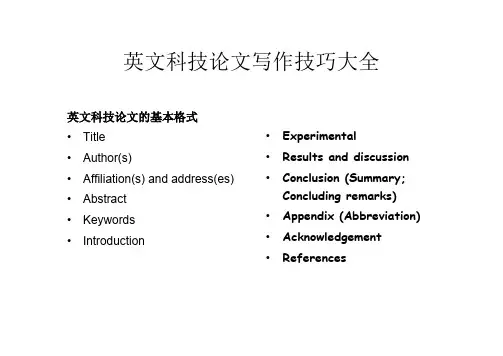
英文科技论文写作技巧大全英文科技论文的基本格式•Title•Author(s)•Affiliation(s) and address(es) •Abstract•Keywords•Introduction •Experimental •Results and discussion •Conclusion (Summary;Concluding remarks) •Appendix (Abbreviation)•Acknowledgement •References2.基本要求(1)Title长短适中,概括性强,重点突出,一目了然。
(2)Author(s)姓氏和名字要容易弄清楚,以免发生以名代姓。
(3)Affiliation(s) and address(es)准确清楚,使读者能按所列信息顺利地与作者联系。
(4)Abstract不宜太详尽,也不宜太简短,应将论文的研究体系、主要方法、重要发现、主要结论等,简明扼要地加以概括。
不要将结论与提要重复使用。
(5)Introduction说明本研究的目的意义。
归纳与本研究密切相关的前人研究结果及有关文献,指出本研究与前人研究的不同之处。
说明本论文要解决的问题及方法、手段等。
不宜将本论文的结果在“绪论”中叙述。
(6)Experimental叙述主要的实验过程、方法、仪器设备、试剂来源及规格等。
不宜将实验结果在“实验部分”中叙述。
(7)Results and discussion是论文的核心部分,要求:–数据及图表的内容及含义交代清楚,有条理;–对数据及现象的归纳、演绎、解释、立论要有逻辑性、自洽性。
–语句要准确、流畅、多样化,不宜重复使用相同的句型和词汇。
(8)Conclusion (Summary, Concluding remarks)简明扼要地归纳出本论文的新发现、新观点、新理论等。
不宜将“结果及讨论”部分的语句直接抄录作为结论。
(9)References要按所投杂志规定的格式准确书写。
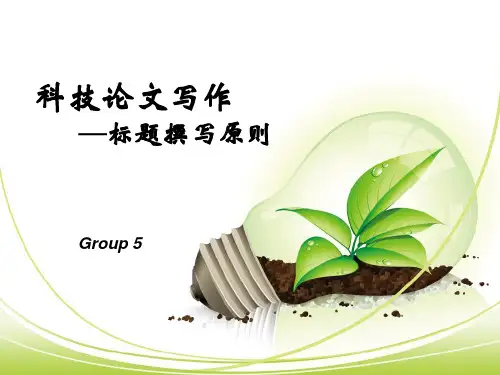
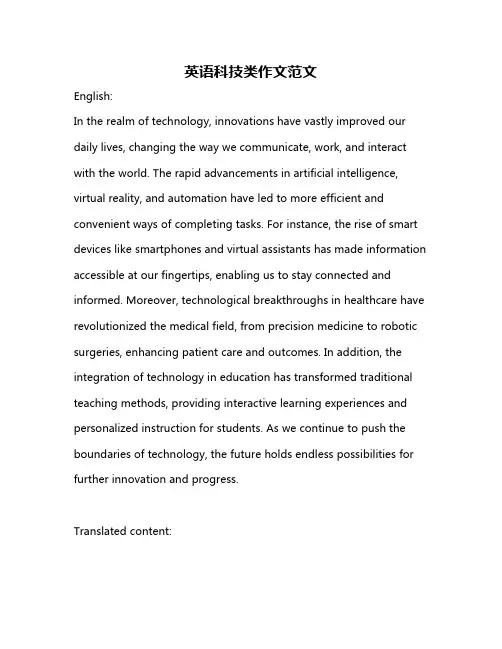
英语科技类作文范文English:In the realm of technology, innovations have vastly improved our daily lives, changing the way we communicate, work, and interact with the world. The rapid advancements in artificial intelligence, virtual reality, and automation have led to more efficient and convenient ways of completing tasks. For instance, the rise of smart devices like smartphones and virtual assistants has made information accessible at our fingertips, enabling us to stay connected and informed. Moreover, technological breakthroughs in healthcare have revolutionized the medical field, from precision medicine to robotic surgeries, enhancing patient care and outcomes. In addition, the integration of technology in education has transformed traditional teaching methods, providing interactive learning experiences and personalized instruction for students. As we continue to push the boundaries of technology, the future holds endless possibilities for further innovation and progress.Translated content:在科技领域,创新大大改善了我们的日常生活,改变了我们与世界沟通、工作和互动的方式。

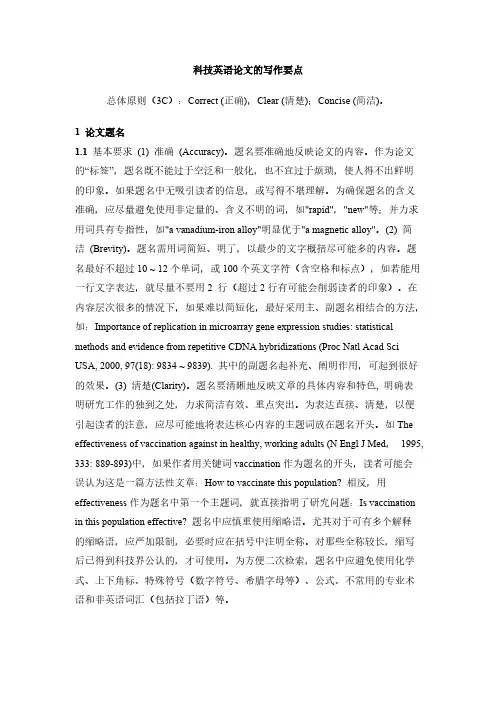
科技英语论文的写作要点总体原则(3C):Correct (正确),Clear (清楚);Concise (简洁)。
1 论文题名1.1 基本要求(1) 准确(Accuracy)。
题名要准确地反映论文的内容。
作为论文的“标签”,题名既不能过于空泛和一般化,也不宜过于烦琐,使人得不出鲜明的印象。
如果题名中无吸引读者的信息,或写得不堪理解。
为确保题名的含义准确,应尽量避免使用非定量的、含义不明的词,如"rapid","new"等;并力求用词具有专指性,如"a vanadium-iron alloy"明显优于"a magnetic alloy"。
(2) 简洁(Brevity)。
题名需用词简短、明了,以最少的文字概括尽可能多的内容。
题名最好不超过10 ~ 12个单词,或100个英文字符(含空格和标点),如若能用一行文字表达,就尽量不要用2 行(超过2行有可能会削弱读者的印象)。
在内容层次很多的情况下,如果难以简短化,最好采用主、副题名相结合的方法,如:Importance of replication in microarray gene expression studies: statistical methods and evidence from repetitive CDNA hybridizations (Proc Natl Acad Sci USA, 2000, 97(18): 9834 ~ 9839). 其中的副题名起补充、阐明作用,可起到很好的效果。
(3) 清楚(Clarity)。
题名要清晰地反映文章的具体内容和特色, 明确表明研究工作的独到之处,力求简洁有效、重点突出。
为表达直接、清楚,以便引起读者的注意,应尽可能地将表达核心内容的主题词放在题名开头。
如The effectiveness of vaccination against in healthy, working adults (N Engl J Med,1995, 333: 889-893)中,如果作者用关键词vaccination作为题名的开头,读者可能会误认为这是一篇方法性文章:How to vaccinate this population? 相反,用effectiveness作为题名中第一个主题词,就直接指明了研究问题:Is vaccination in this population effective? 题名中应慎重使用缩略语。
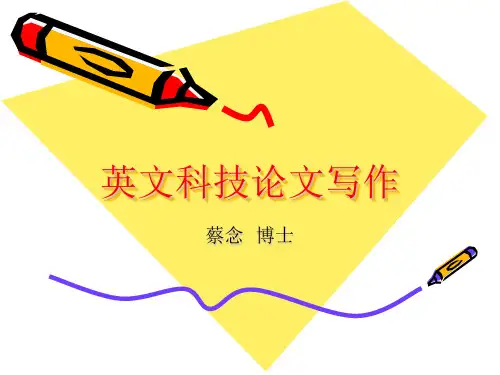
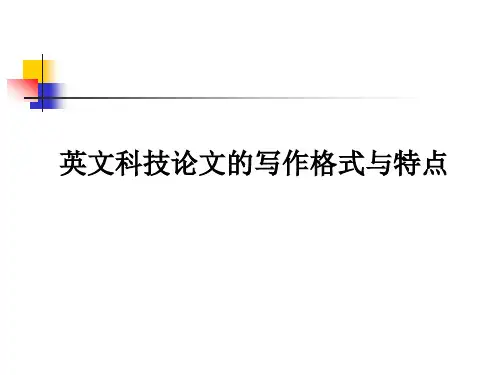
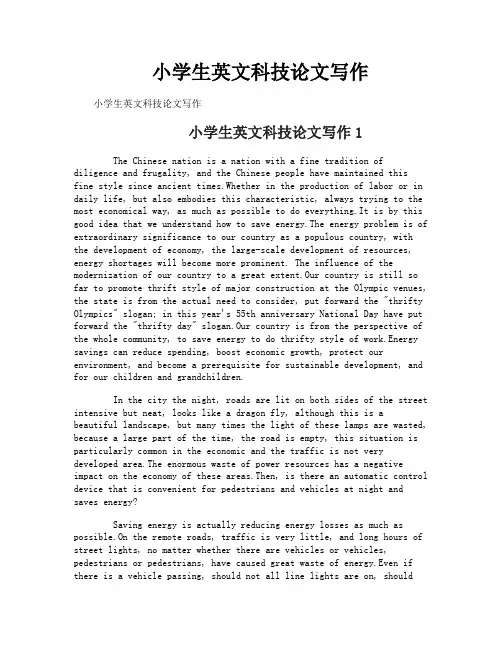
小学生英文科技论文写作小学生英文科技论文写作小学生英文科技论文写作1The Chinese nation is a nation with a fine tradition ofdiligence and frugality, and the Chinese people have maintained thisfine style since ancient times.Whether in the production of labor or in daily life, but also embodies this characteristic, always trying to the most economical way, as much as possible to do everything.It is by this good idea that we understand how to save energy.The energy problem is of extraordinary significance to our country as a populous country, with the development of economy, the large-scale development of resources, energy shortages will become more prominent. The influence of the modernization of our country to a great extent.Our country is still so far to promote thrift style of major construction at the Olympic venues, the state is from the actual need to consider, put forward the "thrifty Olympics" slogan; in this year's 55th anniversary National Day have put forward the "thrifty day" slogan.Our country is from the perspective of the whole community, to save energy to do thrifty style of work.Energy savings can reduce spending, boost economic growth, protect our environment, and become a prerequisite for sustainable development, and for our children and grandchildren.In the city the night, roads are lit on both sides of the street intensive but neat, looks like a dragon fly, although this is abeautiful landscape, but many times the light of these lamps are wasted, because a large part of the time, the road is empty, this situation is particularly common in the economic and the traffic is not very developed area.The enormous waste of power resources has a negative impact on the economy of these areas.Then, is there an automatic control device that is convenient for pedestrians and vehicles at night and saves energy?Saving energy is actually reducing energy losses as much as possible.On the remote roads, traffic is very little, and long hours of street lights, no matter whether there are vehicles or vehicles, pedestrians or pedestrians, have caused great waste of energy.Even if there is a vehicle passing, should not all line lights are on, shouldonly in the vehicle within the effective range of the street light, otherwise it will cause great losses!Pedestrian walking on the road is the same, only in the pedestrian walk within the corresponding range to open the street lamp, to meet the needs of lighting.How can I tell if someone is in the street?We can use an instrument that lights the street automatically when someone or a car is in the street.Then the sensor does not produce air through sound vibration control, but through the vehicles and pedestrians on the road impact and pressure caused by pavement vibration control, the two kinds of vibration is different, otherwise it will be a strange combination of circumstances might be animal sounds, and the roar of the road outside lights, the same as not to the purpose of saving energy.If the noise made by the traffic or pedestrian is too small, the light won't turn onThen, in name only, it doesn't work.Car driving, pedestrian walking, will naturally impact on the ground and pressure, so that the road vibration, which can use the vibration of the road to control whether the street lights bright or extinguished.The device uses shock and pressure vibrations to control the street lights, which can be a good source of energy savings.Power generation needs to consume a lot of resources, save electricity, save resources and protect the environment.Power saving should start from daily life. When using refrigerators at home, the practice of saving electricity is:1.Don't put much food in the fridge2. do not switch the refrigerator door again and again3., in the refrigerator, in the sides and back space, to help the refrigerator cooling4. do not put refrigerators and microwave ovens and other appliances togetherChina is a big producer of batteries and a big consumer of batteries.Now all kinds of electronic products: mobile phone, MP3, Kuaiyitong emerge in an endless stream, electronic calculators, electronic watches, cameras and so on, beyond count, these products require the use of battery.And if the battery after use, not centralized treatment, casually discarded, will cause serious pollution to the environment, for example, a scrap button battery can pollute 600thousand liters of water, it can be seen how dangerous it is.After running out of batteries, we can transport waste batteries tospecialized waste battery processing centers, so that they can help us recycle.This can not only reduce the pollution of the battery, but also can be used second times, killing two birds with one stone.小学生英文科技论文写作2"Ah - ah!"......"I am yawning, squinting, I can not help but raise a question: why do people yawn?What's the secret of yawning?I asked my father and grandpa, and they only talked about it.I can barely understand it, but I still don't understand it.In order to relieve my confusion, I searched the Internet for some information.It turned out that a yawn is six seconds.In this period, can let a person be out of touch with reality, body nerve, muscle relaxation.Yawning, therefore, is a conditioned reflex of deep breathing activity, a physiological response of the brain to nerves when tired, expressing dull, sleepy, or soothing tension in everyday life.Before, Grandpa said yawning was a sign of oxygen deficiency in the brain, which was not the case.On the contrary, by yawning deep breathing, people increase oxygen in the blood and emit more carbon dioxide, which makesus more energetic.People tend to yawn when they are tired, which reminds the body that the brain is tired and needs sleep and rest, so yawning is also a hypnotic method.When people are about to enter the busy work, often yawn, this may be the human body by deep inspiration, so that the blood more oxygen, improve brain activity.In a word, yawning is an instinctive reaction of the human body and has a good protective effect on the human body.What's more, dad said it was wrong.Yawning is awarning that the body needs a break, he said.Looking at the data, I realize that yawning is actually refreshing the brain.And you will find that we often yawn a lot before something important or exciting.It's not that our minds aren't tight enough, but the brain is pumping usdown".When do we yawn?In a long time in the slow yawn or after shallow breathing, a common cause of excessive yawning fatigue, tension, sedentary, do homework or reading, the waistband too tight, overheating room and ventilation.People often yawn when they leave the cinema and other places of amusement. This is not a sign of boredom, but the reason why they sit quietly for too long.After checking the data, I finally understand why peopleyawn.But I have another problem in my heart: hearing people say yawning is contagious.But is it really the case?I don't quite believe it.Butthis time, I don't go online to look up information. I'll do itmyself.That day, I went out with a good friend. It was very late for me to come home.I was yawning and sleepy.Suddenly, I thought it was a good time to do the experiment. I hurried downstairs. Grandma had been losing sleep recently: she couldn't sleep well and sleep hard every night.She always sleeps for a few minutes and wakes up ter, she simply did not sleep all night, watching TV, the morning the people have no spirit, a sickly appearance.All my family were worried about her, whether she would be ill or not.I thought while walking: "since yawning is contagious, then I yawn, and grandma must be yawning."Yawning makes it possible for grandma's nervous nerves to relax.Grandma would fall asleep naturally, and I could finish my experiment.It's really the best way to have the best of both worlds.Think of it, I've got downstairs.Grandma was sitting in front of the television, staring at her bloodshot eyes.I stepped forward quickly, just to call a "grandma", but yawn, but thefirst step on the stage: "ah - ah!"......"Grandma looked at me, and she could not help yawning: "ah - ah!"e, I want to sleep, you can go to sleep.Ah - oh......"As she spoke, she walked back to the room.I looked at Grandma's back, happy to jump three feet high - my experiment succeeded, and grandma's insomnia was cured by me!This yawn is really contagious!The second day, I looked at the book, but also understand why yawning is contagious: brain region when yawning and regional brain activity of sympathy is consistent.That is to say, yawning's "contagion" phenomenon may represent an unconscious mental imitation.。
英语科技论文写作作文1. Technology is changing the way we live, work, and communicate. From smartphones to social media, we are constantly connected to the digital world.2. The development of artificial intelligence is revolutionizing industries such as healthcare, finance, and transportation. Machines are now able to perform tasks that were once only possible for humans.3. The Internet of Things has transformed our homesinto smart homes, where we can control our appliances and security systems with just a few taps on our smartphones.4. Virtual reality and augmented reality are opening up new possibilities in entertainment, education, and training. We can now immerse ourselves in virtual worlds and interact with digital objects in real time.5. Cybersecurity is a growing concern as more of ourpersonal information is stored online. It is essential to protect our data from hackers and cyber attacks.6. The rise of e-commerce has changed the way we shop, with more people choosing to buy products online rather than in physical stores. This has led to the decline of traditional brick-and-mortar retailers.7. Biotechnology is advancing rapidly, with breakthroughs in gene editing and personalized medicine. Scientists are now able to modify DNA to treat genetic diseases and create targeted therapies for patients.8. Quantum computing is on the horizon, promising to solve complex problems at speeds that are unimaginable with traditional computers. This technology has the potential to revolutionize fields such as cryptography, drug discovery, and climate modeling.。
有关科技的英语作文以下是一篇有关科技的英语作文:Technology: Shaping Our FutureIn today's rapidly evolving world, technology plays a vital role in shaping our lives and driving progress. It has transformed various aspects of society, offering numerous benefits and opportunities.One of the significant impacts of technology is in the field of communication. We now have instant access to information through the internet and mobile devices, enabling us to connect with people globally at a click of a button.Moreover, technology has revolutionized education. E-learning platforms provide accessible and flexible learning opportunities, breaking down geographical barriers and enabling widespread knowledge sharing.In the healthcare sector, advancements in technology have led to improved diagnosis, treatment, and patient care. From telemedicine to precision medicine, technology is saving lives and enhancing the quality of care.Technology also drives economic growth and innovation. It enables businesses to increase productivity, improve efficiency, and reach new markets, creating employment opportunities and driving progress.However, along with the benefits, there are also challenges associated with technology. Issues such as data privacy, cyber security, and the digital divide need to be addressed.To ensure the positive impact of technology, it is essential to have a balancedapproach. This includes raising awareness about the ethical and social implications, investing in research and development, and fostering collaboration between different stakeholders.In conclusion, technology is an ever-present force that continues to shape our world. By leveraging its potential and addressing its challenges, we can create a more connected, informed, and progressive future.。
English technology thesis writingName:Studies: Steel metallurgyGlass:题目:The experiment study of use Iron Tailings and Magnesite Tailings Prepare Cordierite-based Glass CeramicsAbstract:This is work make some exploration about how to use iron tailings and magnesite tailings making glass-ceramics feasibility and preparation methods. Thus, turning waste into wealth and raising added-value of iron ore tailings and magnesite talings . In this work, the main raw material are iron ore tailings and magnesite tailings of Anshan area . And, adding nucleation agent and some other oxide follow the certain proportion , then production MgO - Al2O3- SiO2as the mainly crystalling phase of microcrystalline glass. In the experimental, we use DSC to measured nuclear and crystallizing temperature of glass-ceramics and using X-ray diffraction (XRD), scanning electron microscopy (SEM) and so on to test the glass-ceramics phase, crystallized behavior, and the effect of nucleation agent. Through the experiment, we obtained the best proportion of raw materials and tailings dosage as high as 80% , we also determine the most appropriate treatment of the corresponding system. Keywords:Iron tailings;magnesite tailings ;glass-ceramics;crystallization科技论文的组成及其各项的作用1、Title题名又叫题目、文题、标题,是科技论文的中心和总纲。
英语科技论文写作目录第一章概论 (2)1.1 英语科技论文的主要结构组成 (2)1.2 英语科技论文的分类及特点 (3)1.3 英语科技论文的文体特点 (4)第二章英语科技论文语言表达的规范与技巧 (8)2.1 如何使表达准确 (8)2.2 如何使语义连贯 (9)2.3 英语科技论文常用句型结构 (12)第三章英语科技论文的结构组成 (14)3.1 标题 (16)3.2 作者和联系方式 (17)3.3 摘要 (17)3.4 关键词 (18)3.5 引言 (18)3.6 论文主体 (21)3.7 结论 (26)3.8 附录 (28)3.9 致谢 (28)3.10 参考文献 (29)第四章摘要的撰写 (30)4.1 摘要的种类和特点 (30)4.2 摘要的内容和结构 (31)第五章最新科技信息的获取 (37)第六章科技论文的发表 (39)6.1 投稿过程的工作 (39)6.2 评审过程的工作 (41)6.3 出版过程的工作 (41)第一章概论科技论文是科学研究成果的一种展示,是作者以论文的形式向外界公布自己的科学研究成果。
科技论文的撰写与发表是科学研究中一项极其重要、不可马虎的工作,对于非英语母语的作者,如何用英文准确、清晰地表达研究内容和获得的成果,如何使论文顺利发表,成为必须面对的问题。
本课程详细介绍论文写作与发表过程中的一系列具体工作,以期对大家今后的写作提供一些有益的帮助。
1.1 英语科技论文的主要结构组成英语科技论文的整体组织结构和语言风格规范尤为重要,和建造楼房一样,写一篇论文也需要一份蓝图。
英文科技论文蓝图最常见的是所谓IMRAD结构,即:◇Introduction◇Methods◇Results and DiscussionsIMRAD结构的论文简单、清晰、明了并且逻辑性强,因而这一结构被近代学者广泛采用。
这种结构的论文,首先阐述研究的课题和研究的目的,有了清楚的定义以后,再描述研究的方法、试验手段和材料,最后对结果和结论进行详细讨论。
How to Write a Scientific Paper*By George M. WhitesidesDepartment of Chemistry and Chemical Biology, Harvard University,Cambridge, MA 02138, USA科学论文写作*原著:George M. Whitesides (美国)译者:张希,林志宏What is a scientific paper? A paper is an organized description of hypotheses, data and conclusions, intended to instruct the reader. Papers are a central part of research. If your research does not generate papers, it might just as well not have been done. “Interesting and unpublished” is equivalent to“no n-existent.”什么是科技论文?科技论文是集假说、数据和结论为一体的概括性描述,以此向读者论述。
论文是研究工作的中心部分。
如果你的研究没有写成论文,也就等同于没有做研究。
有意义但没有发表,等同于不存在。
Realize that your objective in research is to formulate and test hypotheses, to draw conclusions from these tests, and to teach these conclusions to others. Your objective is not to “collect data.”要意识到研究的目的是为了形成并证实假说,从一些测试中得出结论,并把结论传授给别人。